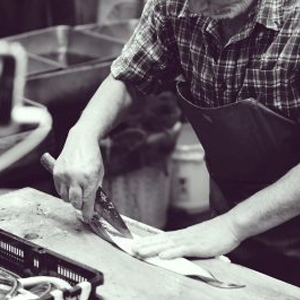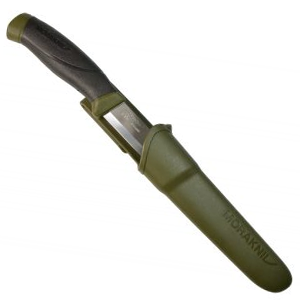Kukris and machetes look similar, but are actually completely different tools. They were invented by different people in different parts of the world, and they serve completely different purposes.
While the surfaces make them both appear similar, this certainly isn’t the truth. To know which one would work the best for you, you’ll need to engage in a kukri vs machete comparison debate.
What’s the Difference between a Kukri and a Machete?
A kukri is a Nepalese tool that’s been used throughout history for many purposes. People in Nepal still use it to this day. It was designed to be used as a utility knife, but is can also be used as a weapon.
A kukri features a steep curve and a round dip at the belly of the blade, coming to a heart-shaped point at the end. This affects the way you swing the blade. It makes it particularly great at chopping through bushes or brush, because everything gets swooped up in the open space and hacked through with the rounded belly.
A kukri is a machete. There are tons of styles of machete, and kukri is just one of them. There are parang, heaby, barong, tapanga, cane, bowie, barong, bolo, golok, panga, and Latin machetes. When you picture a traditional machete in your mind, it’s likely a Latin machete you’re thinking of.
The so called “regular machete” is the Latin machete, which was created in Central America. This machete features a blade that slowly gets bigger towards the tip. The point comes up at the top, leaving a small swooped belly below the tip.
Unlike with a kukri, the blade is mostly straight. It’s easier to chop and hack with the straight blade of a regular machete.

Photo Credit by Mike Petrucci
Pros and Cons of a Kukri
Kukris are designed for a very specific purpose. When you’re having a kukri vs machete showdown, it’s important to consider the ups and downs of both knives. Kukris have a distinct set of pros, but it’s the cons that make a substantial difference.
Pros
- Unique design allows the user to grab and cut in a single swift motion.
- The crook of a kukri makes it an excellent hunting machete, allowing you to clean and dress animals in the field.
- You can perfectly shave or carve tinder with a kukri simply by bracing the back of the blade against your chest and twirling wood through the curve. It takes virtually no effort to make enough tinder to last an entire camping trip.
- Dual surfaces make it easy to alternate between cutting and chipping a tree with the same tool.
- Crook of the body makes it easy to both dig and scrape with a kukri.
Cons
- It’s hard to swing effectively from a close distance with a kukri. The bend in the blade requires you to be slightly further away from the object you intend to strike.
- You need to learn to use a kukri differently from a straight knife. It’s a learning process to acclimate to the shape of the blade and determine how to get it to hit the way you want it to.
- It’s sometimes difficult to get used to the balance of a kukri. The center of gravity is in a different place.
Pros and Cons of a Machete
The machete vs kukri breakdown is about to get a little more interesting. There are some reasons why a machete may outperform a kukri. Weighing the pros and cons is the only way to know.
Pros
- You can cut evenly and straight through with any part of a machete. It runs right across without any disruptive grooves.
- Machetes work just as well at a short distance as they do at a long distance. All you need to do is cut closer or further away from the tang.
- Machetes are practical campsite, fishing, or hiking tools. They’re easy to sheath and carry.
Cons
- Machetes are largely manual tools. Unlike a kukri that uses its shape to help you out, a machete puts all the hard work on you.
- Due to the lack of round swoops, the blade needs to be used like a lever rather than a circular tool.
Who Should Use a Kukri?
Kukris are more like tools than regular cutlery, and this mostly comes from the shape of the blade. If you have a small garden or farm, you’ll really appreciate the convenience of a kukri. It can help you harvest crops with great ease. Things like corn stalks and melon vines are no match for the blade’s curvature.
A kukri is perfect for the person who needs their knife to be a multifunctional tool. If you expect more than just something to make simple cuts, a kukri will deliver for you.
Who Should Use a Machete?
People who don’t want any frills will appreciate the simplicity of a plain Latin machete. It does exactly what it’s supposed to do. It’s fine for most campsite chores and even a little landscaping work.
A machete is a one-trick pony, but it does that trick very well. If you don’t want anything complicated and you’re only looking to hack down a few branches, you’ll undoubtedly prefer a machete.
Which is the Best?
If you require versatility in a knife and prefer to be able to use that knife as a comprehensive tool, the kukri is going to be better for you. If you just want to be able to chop things down and get a fire started, a machete will work fine enough.
Knives are very personal tools, and they’re only as good as they are useful. Get the one you’ll use the most. If you can see a reason to incorporate both into your everyday life, it may be worth picking up one of each.


